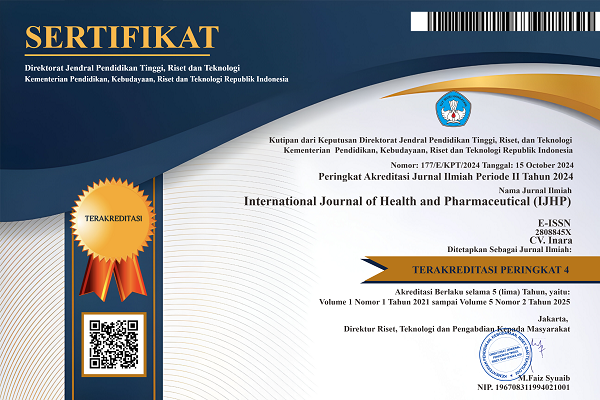An Analysis Of Health Promotion Strategies For Stunting Reduction In The Operational Area Of Minanga Public Health Center, Manado City
DOI:
https://doi.org/10.51601/ijhp.v5i3.418Abstract
Background:Stunting remains a significant public health challenge in Indonesia, including in Manado City. Despite various government initiatives, the prevalence of stunting persists due to complex contributing factors such as poor nutrition, inadequate parenting, and limited access to health services.Objective:This study aimed to analyze the implementation of health promotion strategies—specifically advocacy, social support, and community empowerment—in reducing stunting prevalence in the working area of Puskesmas Minanga, Manado.Methods:A qualitative study with an exploratory design was conducted from June to July 2025. Data were collected through in-depth interviews, direct observations, and document analysis involving 10 purposively selected informants: program managers, community leaders, and mothers of under-five children. Data were analyzed using content analysis guided by the Miles and Huberman model, involving data reduction, display, and conclusion drawing.Results:The findings revealed that (1) advocacy was carried out through mini-workshops and coordination with local stakeholders, although policy support and budgeting remained limited; (2) social support involved active participation of religious and community leaders in encouraging healthy practices, yet lacked formal community-based structures; and (3) community empowerment focused on cadre training and health education through monthly Posyandu activities, though constrained by funding and attendanceissues.Conclusion:Health promotion strategies—when applied in an integrated manner—showed potential to reduce stunting prevalence. However, sustainability depends on stronger policy commitment, consistent funding, and wider community involvement. Strengthening intersectoral collaboration and community ownership is essential to enhance the effectiveness of stunting prevention programs.
Downloads
References
Ahmad, K. (2014). Promosi Kesehatan. Jakarta: Raja Grafindo Persada.
Alba, A. D., Suntara, D. A., & Siska, D. (2021). The relationship between BBLR history and stunting incidents in toddlers in the work area of the Sekupang Health Center, Batam City in 2019. Journal of Research Innovation, 1(12), 329–334.
Armstrong, G., & Kotler, P. (2015). Dasar-dasar Pemasaran (A. Sindoro & B. Molan, Trans.). Jakarta: Prenhalindo.
Assauri, S. (2017). Manajemen Pemasaran. Jakarta: PT Raja Grafindo Persada.
Budio, D. (2019). Strategi Promosi Kesehatan dalam Pencegahan Penyakit. Jakarta: CV. Mitra Cendekia Press.
Hamdani, M. (2013). Promosi Kesehatan untuk Kebidanan dan Keperawatan. Jakarta: Salemba Medika.
Ismainar, H. (2022). The effect of health education using leaflet media on the knowledge of pregnant women about stunting prevention. Jurnal Kebidanan, 11(2), 87–94.
Kementerian Kesehatan Republik Indonesia. (2016). Peraturan Menteri Kesehatan Nomor 97 Tahun 2014 tentang Pelayanan Kesehatan Masa Sebelum Hamil, Masa Hamil, Persalinan, dan Masa Sesudah Melahirkan, Pelayanan Kontrasepsi serta Pelayanan Kesehatan Reproduksi. Jakarta.
Kementerian Kesehatan Republik Indonesia. (2017). Pedoman Umum Program Indonesia Sehat dengan Pendekatan Keluarga. Jakarta: Kemenkes RI.
Kementerian Kesehatan Republik Indonesia. (2018). Laporan Nasional Riskesdas 2018. Jakarta: Badan Penelitian dan Pengembangan Kesehatan.
Kementerian Kesehatan Republik Indonesia. (2023). Data Stunting Nasional Tahun 2023. Jakarta: Direktorat Gizi dan Kesehatan Ibu dan Anak.
Marrus, D. (2017). Komunikasi Kesehatan Masyarakat: Pendekatan Interdisipliner. Yogyakarta: Graha Ilmu.
Miles, M. B., & Huberman, A. M. (2020). Qualitative Data Analysis: An Expanded Sourcebook (3rd ed.). Thousand Oaks, CA: Sage.
Ngaisyah, N. (2015). Factors influencing stunting in toddlers: An epidemiological review. Jurnal Gizi dan Dietetik Indonesia, 3(2), 104–110.
Novianti, R., et al. (2020). Determinants of stunting in children under five years in Indonesia. Malaysian Journal of Public Health Medicine, 20(3), 223–229.
Olsa, Y., Sulastri, D., & Anas, E. (2017). Association between maternal knowledge and stunting among school-entry children in Padang. Jurnal Kesehatan Andalas, 6(2), 153–160.
Rahayu, T., Anindyajati, G., & Puspitasari, D. (2018). Mother's education and stunting incidence: A cross-sectional study. Jurnal Gizi dan Pangan, 13(1), 21–28.
Ramiza, R., et al. (2021). Faktor-faktor penyebab stunting pada balita: Studi kasus di Provinsi Aceh. Jurnal Kesehatan Masyarakat Aceh, 6(2), 80–88.
Solang, M., et al. (2016). Strategi Promosi Kesehatan Berbasis Pemberdayaan Masyarakat. Makassar: Pustaka Nusantara.
Subaris, M. (2016). Pemberdayaan Masyarakat dalam Promosi Kesehatan. Surabaya: Airlangga University Press.
Sugiyono. (2016). Metode Penelitian Kuantitatif, Kualitatif, dan R&D. Bandung: Alfabeta.
Sugiyono. (2022). Statistika untuk Penelitian. Bandung: Alfabeta.
Syafiga, N. (2023). Peran Musrenbang dalam peningkatan pembangunan desa. Jurnal Ilmu Pemerintahan, 9(1), 33–44.
Tiyas, R., Putri, R. D., & Wulandari, S. A. (2023). The role of social support and religious leaders in maternal behavior change toward stunting prevention. Jurnal Promosi Kesehatan Indonesia, 18(2), 110–117.
WHO. (2014). Global Nutrition Targets 2025: Stunting Policy Brief. Geneva: World Health Organization.
WHO. (2020). Levels and Trends in Child Malnutrition: UNICEF/WHO/World Bank Group Joint Child Malnutrition Estimates. Geneva: WHO.
Wirawan, Y., et al. (2025). Advokasi dalam promosi kesehatan berbasis data: Studi implementasi di wilayah timur Indonesia. Jurnal Administrasi Kesehatan Indonesia, 13(1), 55–67.
Yadika, A. N. D., Berawi, K. N., & Nasution, S. H. (2019). Dampak jangka panjang stunting terhadap perkembangan otak anak. Jurnal Ilmu Gizi Indonesia, 4(3), 117–123.
Yuliani, M. (2021). Peran posyandu dalam pencegahan stunting di Indonesia. Jurnal Kesehatan Komunitas, 7(1), 45–52.
Downloads
Published
Issue
Section
License
Copyright (c) 2025 Claudia Wattie, Erwin Kristanto, Erlin David Kaunang

This work is licensed under a Creative Commons Attribution-NonCommercial 4.0 International License.























